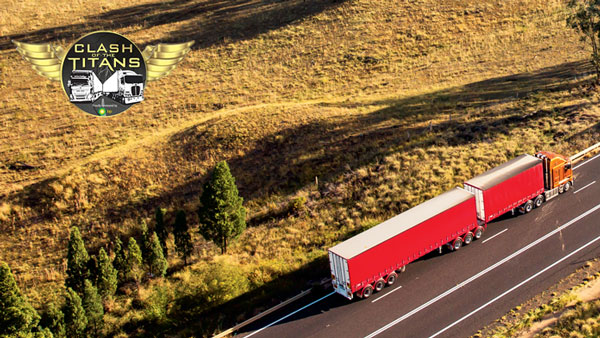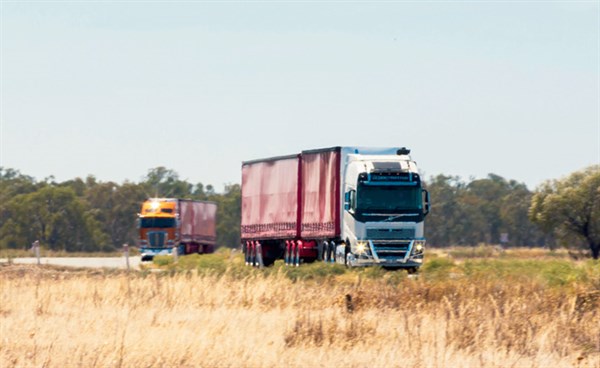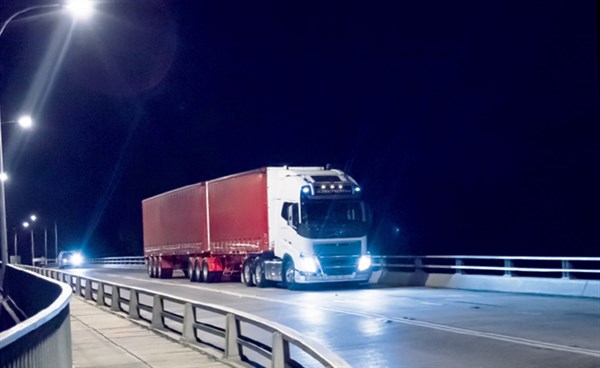After some 3,500km on the road from Melbourne to Brisbane and back again, Matt Wood looks back at the week-long trek with the Kenworth K200 and the Volvo FH.
With Steve Brooks and myself both safely parking the trucks up back in Melbourne, it was time for me to look back at our week on the road.
The shiny Kenworth K200 versus the understated techno powerhouse Volvo, the raging rock star and the Swedish supermodel. Both were running neck and neck on performance yet were chalk and cheese to drive and to live in. But, neither rig put a foot wrong for the whole week.
On the road, the Cummins seemed to have a performance edge at the bottom of a hill, but the FH soon found its footing around the middle of the climb and hauled.
The Eaton UltraShift Plus ‘box in the Kenworth needed more intervention to keep the cab-over singing. But the I-Shift tranny in the FH still needed a tickle here and there to make the most of the 16-litre donk.
Silky smooth sums up the Volvo in most aspects, while the Kenworth feels planted on the road. The set forward steer axle of the stretch cab feels entirely predictable on all road surfaces though that does provide some characteristic chop to the ride.
That steer axle position however, does give the Kenworth a leg up in the weight distribution department as well, and its lighter tare weight gives flexibility especially in bulk applications.
My involvement in the Kenworth build gave me a sense of ownership; I built my own diesel fuelled fantasy, a personal expression. And it felt like my truck.
For long-haul work the bunk is a huge selling point, even in 2.3m fleet guise. The ‘Woody Wagon’ was a joy to live in, that stretch cab is just so damn usable.
The Kenworth is an engaging drive that lets the driver read the road though their ears, eyes and through the wheel, and it hasn’t succumbed to over complication during its evolution.
The Cummins e5 has given the cab-over the driveability that it needs. Any Kenworth at this level of spec is a raging, profane love song to trucking in Australia.
It’s an elegantly simple tool for a tough job.
But the Volvo FH is something else. It was ahead overall on fuel but it’s much more than that.
As much as I’m reluctant to make big statements the FH16 Volvo has more finesse and poise on the road than any commercial vehicle I’ve driven to date. It’s simply that good. I-Shift, I-Roll and Active Cruise all work together seamlessly in a beautifully integrated package.
That 16-litre engine is a smooth torque machine that just keeps on giving when driven properly.
The performance of the Volvo’s integrated drive train is seriously impressive.
However, the depth of the FH cab is a serious hurdle, the FH16 Globetrotter XL is Volvo’s premium line-haul offering yet the cab is better suited to shuttle work and single night accommodation rather than as a live in proposition.
Even the new range of Mercedes-Benz trucks due for Australian release next year give the FH a run for its money in the bedroom stakes. The Volvo is a million dollar apartment with a couch instead of a bedroom. Armed with an Aussie-sized cab this truck would be very hard to pass up.
The K200 is the heart decision that is backed up by a liveable cab, and it’s a major attraction. If you follow the first, second and third life business model of truck ownership it’s hard to ignore the K-Dub’s heritage of durability.
It’s also hard to ignore the massive dealer and parts network, and sad as it is to admit, I kept catching myself admiring it.
The FH feels like the head decision mainly because it’s so damn smart.
The big Volvo is the first heavy vehicle I’ve driven that’s given me a potential real world glimpse of trucking’s future, where the driver is in command of systems rather than moving levers. The FH platform represents a world of future possibilities.
Fuel for thought
Fuel results made for interesting reading. The FH carries 1,220 litres of juice but tipped the scales at 6,480kg on the steer axle loaded with three-quarter full tanks. This is sailing pretty close to the wind with our current steer axle weight regime.
The K2 carries 1,500 litres yet weighed in at just 6,008kg three-quarter fuelled.
However, the FH pulls its fuel from the bottom of the tanks while the K2 uses a pick-up which drops the usable fuel load by at least a couple of hundred litres.
According to Controller Area Network (CAN) data, the ‘Woody Wagon’ returned a fuel economy average of 1.65km/l. The FH returned an average figure of 1.73km/l.
However, we also recorded the two fuel fills to a predetermined mark on the tanks of both trucks. We also made sure that both trucks were fuelled from the same pumps. Using this method the Kenworth returned 1.63km/l and the Volvo 1.65km/l. According to the pump readings there was just 19 litres between the two trucks over the 3,500km trip.
It would also be fair to say allowing for some flow-through on cross lines between tanks, the truth is likely to be between both sets of figures.
Given that both trucks had just under 10,000km on the clock I’d expect those numbers to improve over the next 50,000km or so.
We had to rely on CAN data alone for AdBlue figures. The magnetic AdBlue pump nozzles make it difficult to accurately tell how much is in the tank, which made it virtually impossible to measure physically. According to Dynafleet, AdBlue usage for the FH came in at 5.6 per cent of fuel burn which is pretty much on the knocker for the Volvo.
A post trip download of the Cummins ISXe5, however, inexplicably returned the same AdBlue figure as the Volvo; 5.6 per cent of fuel burn. Given that we only put 120 litres of AdBlue in the K200 over the whole trip I’d have to say this is very much out of character for the big red 15-litre and a far cry from the 2 to 3 per cent I was expecting. I suspect something was amiss with the Cummins’ Electronic Control Module (ECM) reporting.
Some may scoff at the fuel figures of both trucks, but it’s worth noting both trucks spent the entire trip grossing more than 61 tonnes. Average B-double weights are more likely to be around the 55 tonne mark on these routes. On top of that we had a howling headwind heading south out of Goondiwindi. Those fuel figures are credible real-world figures from new trucks running at a heavier than usual weight.
Sizing up
The XXL Aussie cab of the previous model FH had some loyal adherents both here in Australia and in parts of Europe. One Swedish operator took matters into his own hands and enlisted Dutch truck customisers Van Winkoop to add 600mm of depth to his new FH. The result was a stunning one-off XXL.
However, the truck can’t be registered in its home country due to the local cab crash integrity regime. Instead it has to operate on German rego.
Therein lies the big issue. How do you pull apart one of the safest cabs in the world and make it bigger for a low volume market like Oz?
Hopefully we’ll get to find out one day.
Specifications
Make/model: Kenworth K200 2.8m stretch cab
Engine: 15-litre Cummins ISXe5 selective catalytic reduction (SCR)
Power: 600hp (447kW)/2,050ft-lb (2,779Nm)
Transmission: 18-speed Eaton UltraShift Plus automated manual transmission (AMT)
Final drive ratio: 4.1:1
Fuel capacity: 1,500 litres
AdBlue capacity: 200 litres
GCM: 90,000kg
Make/model: Volvo FH16 Globetrotter XL
Engine: 16-litre Volvo D16G600 Euro 5
Power: 600hp (447kW)/2,075ft-lb (2,813Nm)
Transmission: 12-speed Volvo I-Shift AMT
Final drive ratio: 3.40:1
Fuel capacity: 1,220 litres
AdBlue capacity: 150 litres
GCM: 70,000kg





